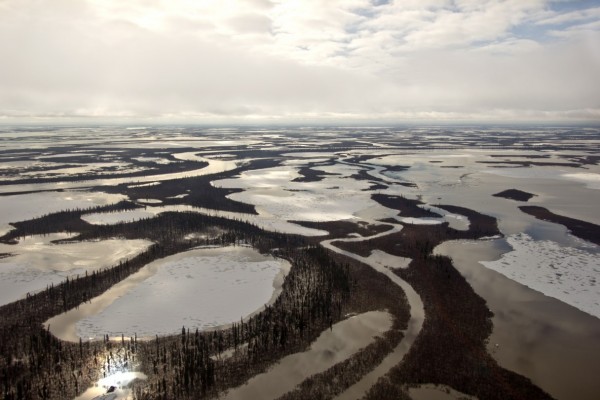Why Québec’s big bet on hydropower is bad news for the climate
The notion that Québec can export clean power to the US, as well as decarbonize the province, ‘no longer holds up to analysis’

Photo by Fré Sonneveld/Unsplash
Hydro-Québec’s goal to be “the battery of North America” recently received a setback in Maine. Some 60 percent of voters in a November 2 referendum in that state rejected the New England Clean Energy Corridor (NECEC)—a 233 kilometer high-voltage, direct-current transmission line intended to bring power from Hydro-Québec’s dams through Maine and into Massachusetts for the next 20 years.
Voters in Maine acted to protect their forests and environment from the clear-cutting that would be needed to erect the massive hydroelectric corridor, but they may also have been responding to current scientific thinking that no longer sees all hydropower as “green.”
Just days before the referendum vote, the Bangor Daily News published an op-ed by MIT Earth Sciences professor Bradford H. Hager, who warned that the New England Clean Energy Corridor is “unlikely” to reduce carbon emissions, but “may well increase them.”
Hager wrote: “I once believed that all hydropower is clean. But recent research shows clearly that some hydropower is not. Unfortunately, the intuitively appealing notion that Québec can export clean power to Massachusetts and New York, as well as decarbonize Québec, no longer holds up to rigorous analysis.”
Hager explained that hydro dam reservoirs that are in deep, narrow valleys “as in Switzerland” do provide clean power, but shallow dam reservoirs that flood vast forest lands “as in Brazil and Québec” do not. In Québec, the flooded trees and soil from the boreal forest decay under water in the reservoirs for decades and continually release substantial methane and CO2 for 50 years or more. As a greenhouse gas, methane is dozens of times more detrimental to the climate than CO2.
That same decomposition in the dams’ reservoirs also accelerates the production of deadly methylmercury pollution that poisons inhabitants of the region.
Legal action
To get a sense of just how vast Hydro-Québec’s infrastructure for the NECEC is, we need only look at the 2020 statement made by three First Nations in opposition to the project. The Innu First Nation of Pessamit, the Atkamekw First Nation of Wemptaco and the Anishnabek First Nation of Pikogan denounced the “33 production structures, 130 dams and dikes, 10,400 square km of reservoirs, and tens of thousands of transmission, distribution and road lines [that] have been illegally installed on our lands and waters.”
Maine voters’ rejection of the NECEC is the second time a proposed Hydro-Québec export transmission corridor has been stalled. In 2018, a similar project into New Hampshire, called Northern Pass, was stopped by public opposition.
Just hours after the Maine referendum results, Avangrid Inc., the parent company of Central Main Power and NECEC Transmission LLC, filed a lawsuit in Maine Superior Court, challenging the constitutionality of the referendum.
Hydro-Québec and Québec Premier François Legault have also announced intentions to take legal action to ensure the NECEC goes forward. But getting the populace onside may take more than the courts can deliver. In advance of the November 2 referendum, Hydro-Québec spent $18 million on public-relations efforts and ads to try to convince Maine voters to accept the project, but a significant majority rejected it.
Supporters of the “No CMP Corridor” campaign stage a rally in Augusta in opposition to a planned hydroelectric power corridor through western Maine, February 3, 2020. Photo by Robert F. Bukaty/AP.
Paris Climate Agreement
It’s not widely known that in 2015, at the Paris Climate negotiations, more than 300 civil society organizations from 53 countries released a “global manifesto” calling on governments and financiers at the talks to keep large hydropower projects out of climate initiatives. Calling large hydro dams “a false solution” to climate change, these organizations stated that large dams “emit massive amounts of methane, make water and energy systems more vulnerable to climate change, and cause severe damage to critical ecosystems and local communities.”
These groups were especially concerned that funding sources such as the United Nation’s Clean Development Mechanism, the World Bank’s Climate Investment Funds, and various green bonds would be financing hydro development around the world on the premise that hydropower is “clean and green.”
Their press release stated: “The dam industry advocates that large hydropower projects be funded by the Green Climate Fund, and many governments boost them as a response to climate change through national initiatives.” The groups noted that “at least twelve governments with major hydropower sectors” have included the expansion of hydropower generation in their reports on their intensions for Nationally Determined Contributions for cutting emissions. “Support from climate initiatives is one of the main reasons why more than 3,700 hydropower dams are currently planned and under construction around the world,” the press release stated.
A 2016 follow-up study, published in Bio Science by ten authors in five countries (US, Canada, China, Brazil and the Netherlands), found that dam reservoirs produce 25 percent more methane than previously thought, emitting a billion tons of greenhouse gas emissions annually. They urged that reservoir emissions be included in global carbon budgets, which they currently are not.
Dam nation
It is not known whether Canada is one of those “twelve governments with major hydropower sectors” that in December 2015 included hydropower expansion as a goal for cutting emissions, but Canada is second only to China in its dam-building, with some 600 dams across the country by 2015.
Then in 2016, the Justin Trudeau Liberal government released its Mid-Century Long-Term Low-Greenhouse Gas Development Strategy, boasting that Canada would reduce carbon emissions and meet its Paris Climate targets by generating 100,000 megawatts of new hydropower.
According to esteemed scientists J. David Hughes and David Schindler (now deceased), that would mean another 118 dams (of Site C size) across the country—a plan that has received almost no mainstream media coverage at all, and which no political party leader has openly criticized.
The Mid-Century Strategy calls hydropower “non-greenhouse gas emitting” and states that “Interprovincial, interjurisdictional, and intercontinental cooperation will enhance integration of clean electricity generation to satisfy growing demand. Canada’s contribution towards global GHG abatement could include providing clean power to our continental neighbours, as well as clean power services to the international community.”
The Mid-Century Strategy further states: “The integration of electricity markets between Canada and the US includes 35 physical interconnections crossing the border and over $2.3 billion in Canada-US electricity trade revenue. In August 2015, the US Environmental Protection Agency released the final version of the Clean Power Plan which could reduce GHG emissions from the US power sector by 32% from 2005 levels. Under certain conditions, US states can help meet their emissions reductions targets through imported clean electricity from Canada.”
President Obama’s Clean Power Plan expressly allowed states to import Canadian hydropower, leading the North American Electric Reliability Council to predict that Canadian power exports to the US could triple by 2030.
But David Schindler told The Tyee that the Canadian government calling hydropower “non-emitting” is completely dishonest. “In extreme cases, energy from dams can produce as much greenhouse gas as burning coal,” he said. “Some reservoirs can release methane and CO2 for more than a hundred years.”
And when you include “the emissions from building and producing materials for a dam, as well as the emissions from clearing forests and moving earth, the greenhouse gas production from hydro is expected to be about the same as burning natural gas,” said Schindler.
The proposed New England Clean Energy Connect would have supplied hydroelectric power from Québec to the New England region. Mainers voted on Tuesday, November 2 to reject the project. Image courtesy of Hydro-Québec.
The New York hydro deal
While Vermont voters provided a setback to Hydro-Québec’s (and Canada’s) big plans, another electricity export deal is moving forward.
In late September, Hydro-Québec signed a tentative $20 billion deal with the State of New York that would see Hydro-Québec export 10.4 terawatt-hours of electricity per year for the next 25 years, pending further approvals.
The proposed high-voltage transmission line from Québec would connect to the proposed Champlain Hudson Power Express (CHPE)—a 546 kilometer, underground and underwater line running from La Prairie, Québec to New York City, with an interconnection occurring under the Hudson River.
The Champlain Hudson Power Express project is backed by financial giant Blackstone Group through its subsidiary Transmission Developers Inc. Blackstone’s head honcho Stephen Schwarzman has been advising the Trudeau govrnment on a variety of issues since the 2015 federal election, including free trade negotiations.
Former prime minister Brian Mulroney has been on the board of the Blackstone Group since 2007, when he was appointed along with Lord Nathanial Rothschild, heir to the banking dynasty.
The Chairman of the Board for Transmission Developers Inc. is David Peterson, the former premier of Ontario.
The Champlain Hudson Power Express project would rely on power generated by Hydro-Québec’s highly controversial $5 billion Romaine River complex, which is flooding 100 square kilometers of forested land.
In 2019, the environmental group Riverkeeper reversed its support for the CHPE, citing environmental and social justice issues. Similarly, in that same year three energy planners and environmentalists wrote in The Guardian that “…there is nothing ‘clean’ about hydropower. Building the CHPE would require excavating a trench down the spine of the Hudson Valley, a costly and environmentally disruptive enterprise. Construction could potentially stir up long-buried carcinogenic PCBs in the Hudson River, the nation’s largest superfund site, threatening a recovery process championed by advocates for decades.”
The writers also refer to the “cultural genocide” of First Nations in Québec. “Although Hydro-Québec has promised to supply NYC’s municipal energy without building new dams, the city will nonetheless be investing long-term in a company that has been building a series of new dams since the late 2000s,” and exposing Indigenous communities “to poisonous methylmercury directly resulting from damming rivers and flooding forests.”
The North American Megadam Resistance Alliance and another organization called Save the World’s Rivers have both labeled Hydro-Québec as “heavily greenwashed.” At COP26, environmentalists are attempting to get emissions from hydropower included in global carbon budgets. Whether that will be possible during 12 days of negotiations is a huge question.
Canadian freelance writer Joyce Nelson is the author of seven books. She can be reached through her personal website.










